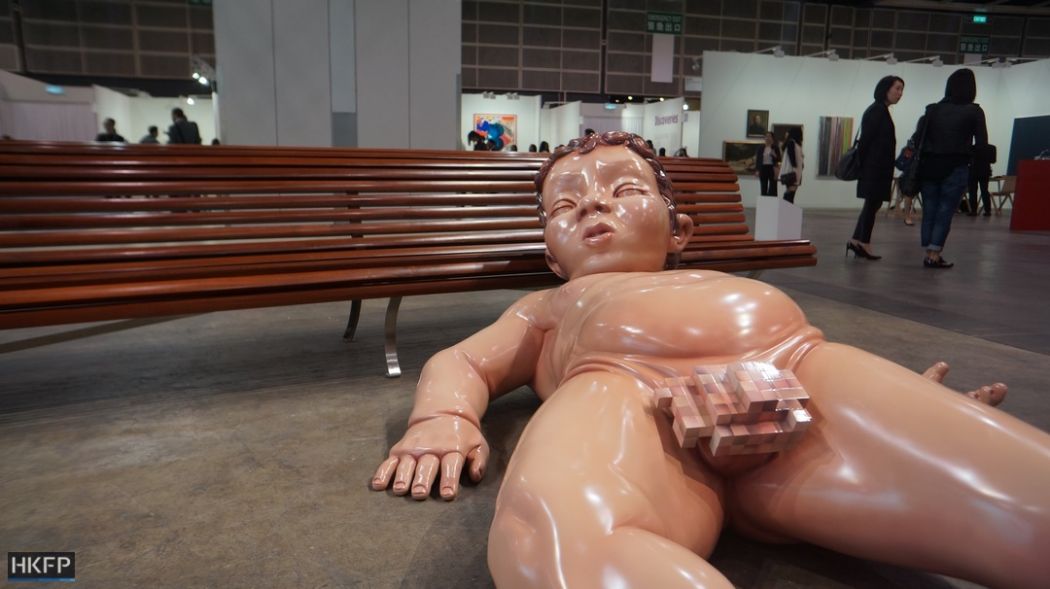Huang Xiaoshuai and his wife last year splashed out US$70,000 for a large painting of fish by Oscar-winning actor Adrien Brody — part of a growing clique of young, affluent Chinese art enthusiasts building their own high-end collections.
The picture now hangs in their Shanghai home and the couple, along with other mainland collectors, have flown in to attend VIP events at this week’s Art Basel in Hong Kong where they are hoping to indulge their taste for contemporary Asian and European art.

Each year Huang and Wei Mengyuan set aside US$1.5 million to spend on art — half from Huang’s salary and the rest from family funds.
Huang, an investment banker, says he and his wife first got into collecting when they were deciding how to decorate their new home.
“We have friends who deal art. They gave me some advice (on how) to buy some paintings or sculptures to put in our house,” says Huang.
See also: HKFP Lens: Highlights from Art Basel as collectors and galleries converge in Hong Kong
A hobby turned into a passion — now the couple say they buy art not only as decoration but also as an investment.
Wei says that, unlike jewellery or real estate, art allows her to form an emotional connection and both say they like to meet the artists who create the works they buy.
This year at Art Basel, the couple will be looking out for pieces by Sweden-based sculptor Klara Kristalova and Chinese artist Sun Xun.

“I want to see (the artworks) in person, otherwise I can’t get the feeling,” Huang said, adding that he hoped friends and family would enjoy viewing his latest purchases when they visit his home.
“It’s not to sell but to share,” he said.
Stylish collections
China is the third-largest art-buying market in the world and leads the auction sales segment, according to a new report by Art Basel and UBS.
Although sales have been dampened by an economic slowdown there have been some stellar purchases in recent years.

Taxi-driver-turned-tycoon Liu Yiqian has made the biggest headlines, buying a tiny Ming Dynasty “Chicken Cup” for US$36 million at Sotheby’s in 2014 before drinking tea from it.
Liu, who founded the Long Museum in Shanghai, then branched out into Western art, bagging a Modigliani for US$170.4 million at a Christie’s New York auction in 2015.
But gallerists and art dealers say the growing band of well-travelled, wealthy young buyers are also now making their mark, albeit with lower budgets and sometimes using their parents’ money.
With a critical eye and in-depth knowledge, they are departing from the more traditional tastes of established Chinese collectors and are building collections in their own edgier style.
Hong Kong-based gallerist Pascal de Sarthe says their passion and know-how has created a “much broader market” which has impacted dealers.

“Now we have more requests about Western art than we used to,” thanks to young Chinese collectors, he said.
Adventurous taste
Another Hong Kong gallerist, Pearl Lam, said the market in China was generally becoming more adventurous.
“Chinese collectors, as well as artists, are becoming more exposed to art from different parts of the world and are becoming more accepting of works from emerging countries or by emerging artists,” she told AFP.
Some contemporary artists in China are themselves also turning to collecting.

Beijing-based artist and poet Wang Ai, 46, says he gathers works to document the times.
He and a friend are currently building an exhibition space in the eastern Chinese province of Zhejiang so that they can share their collection with the public.
The pair focus on works by Chinese contemporary artists and Wang says they prioritise the intellectual merit of the art when purchasing, while also considering their market value.
They have spent from US$3,000 to more than US$70,000 on individual pieces.
“Collecting… has to do with my understanding of my own culture,” Wang told AFP.
“Contemporary art is a part of history — you can’t buy history, but you can form a relationship with it.”
